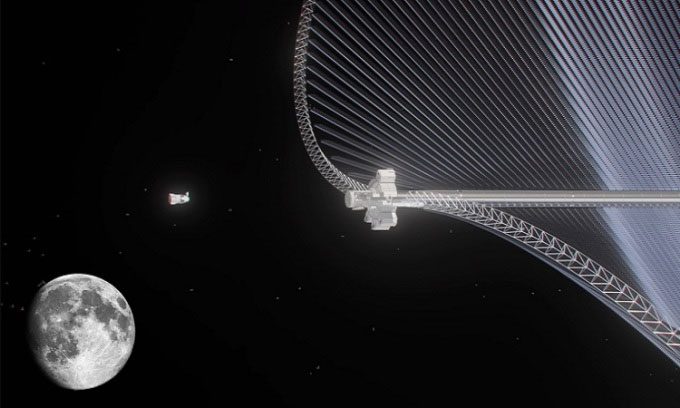Swiss Engineers Plan to Build Solar Farm to Provide Continuous Power to Lunar Base via Microwaves.
Unlike in space, collecting solar energy on Earth is limited by the number of daylight hours. As a result, researchers have long developed ideas and experimented with building satellites that function as solar farms, capable of transmitting unlimited clean energy back to Earth via microwaves. A new project is emerging that aims to transmit solar energy to the Moon.

A solar power station orbiting above the Moon could be feasible in the future. (Photo: ESA)
According to a recent announcement from the European Space Agency (ESA), a team of engineers from the Swiss company Astrostrom has detailed the Moon-Earth Power Station – Large (GE⊕-LPS). Inspired by the shape of a butterfly, the GE⊕-LPS consists of many V-shaped solar panels arranged in a spiral configuration over an area of one square kilometer. Theoretically, this size would allow the satellite station to transmit a power beam of up to 23 megawatts (MW) to the lunar base. One megawatt of electricity can supply 200 households in Texas during peak demand periods.
According to the engineers’ research, both the GE⊕-LPS and the solar panels could be constructed using materials found on the lunar surface, such as iron pyrite. Iron pyrite exists on Earth but its components are also present in the lunar regolith. Combining these components allows for synthetic production. With each crystal absorbing light approximately 1/400 millimeter in size, iron pyrite could serve as an outer coating to reflect light for the solar panels.
The power station is designed for long-term human occupancy, located at the Lagrange point between Earth and the Moon, at an altitude of 61,350 km above the Moon. The Lagrange point is a position between two celestial bodies where gravitational and centrifugal forces cancel each other out, creating a balance point that requires minimal orbital adjustments.
Although such a project appears financially and logistically challenging, researchers believe that building and launching satellites from the lunar surface could be easier and more cost-effective than launching from Earth. In fact, the Astrostrom engineering team estimates that launching from the Moon requires a velocity change to enter geostationary orbit that is less than one-fifth of that needed for launching satellites from Earth.
“When projects like GE⊕-LPS demonstrate the feasibility of producing and assembling components of solar power satellites, we can scale up to create more solar power satellites from lunar resources to serve Earth,” said Sanjay Vijendran, project director of ESA’s SOLARIS space solar power research.





















































